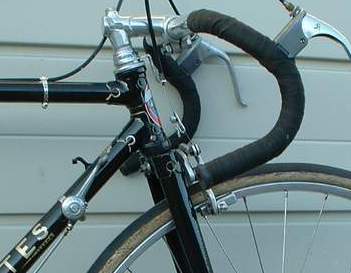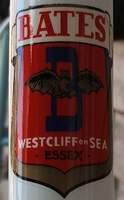Bates Cycles
Posted: Thursday 28th May 2020
Bates Cycles and Cantiflex frame tubes
Bates is one of the most highly regarded of the English lightweight frame builders. The company became famous for its racing successes of the 1930s, 1940s and 1950s but it is probably best known for the unique ‘Cantiflex’ frame tubing and odd-shaped ‘Diadrant’ front forks used for many of their racing and club machines. These ingenious features were not mere gimmicks but were genuine improvements. The result was a responsive frame of unusually high rigidity while the front fork design was claimed to possess the ability to effectively absorb road shocks despite the short wheelbase and steep head angle. What is more remarkable is that these designs were developed and patented way back in the 1930s when lightweight cycles were in their infancy. Today, Bates cycles are highly sought after by enthusiasts and serious collectors.

Before delving into the history of Bates it should be made clear that there were two London lightweight makers with the name Bates. Horace Bates and EG (Eddie) Bates were brothers and they initially produced frames and cycles as a partnership under the name Bates Brothers. They went their separate ways after the war with the original company continuing under Horace Bates (as Bates of London and later Bates of Westcliff), while Eddie Bates traded as EG Bates Cycles. It is the story of Horace Bates and his Cantiflex frames that is the subject of this feature.
Bates: the early years – a bright future
Bates Cycles was set up in Swete Street, London E13 in 1926 by Horace T Bates. That same year he began to produce his first frames and in 1927 was joined in the business by his brother EG (Eddie) Bates, The name was changed to Bates Brothers. Before long, they moved to larger premises at 632 Barking Road. Even at this early stage the Bates brothers specialised in high performance lightweights of exceptional quality for the clubman and racing cyclist. Both road and track machines were produced and a good reputation was soon established in the London area and beyond. The symbol used on the name badge of Bates machines was that of a bat and this has remained throughout the very long production history of Bates cycles.
By the early 1930s Bates offered club and racing machines as well as framesets. In 1934 they exhibited at the Lightweight Cycle Show with four solo models and two tandems. Their range-topping Volante was a track model that weighed a little over 15lbs on silk tubulars and aluminium sprint rims. The demand for Bates Brothers cycles was such that the company expanded into a larger shop just over the road (589-591 Barking Road), while the old shop was converted for use as the frame-building workshop. The men taken on to build the frames and machines were all racing men and of course they rode Bates cycles. One of them, Stan Butler, was a prominant rider in national time trial events and his successes certainly helped Bates Brothers reputation.
That reputation was further enhanced when the Bates Cantiflex frame and Diadrant front fork was announced at the end of 1935. The new designs were advertised in the cycling press and soon proved their worth in winning races right up to the very highest levels on road and track.

Not only did this new design work supremely well, but Horace Bates had clearly pulled a master stroke in that the new frame and fork could be instantly recognised as a Bates – even from a brief glance as a rider sped past or from a fuzzy photograph on 1930s newsprint. The unique and easily identifiable design of the Bates with its strange double-curved fork design proved to be a real boon in marketing terms. Not only did it win races but it was clearly different to other racing cycles at a time when competition was fierce.
This all happened when the sport of cycling was gaining popularity fast. Not surprisingly, the mid to late 1930s was a period of expansion for Bates cycles and, in 1936, the year that Cantiflex frames first became available, the frame workshop was making on average 9 or 10 frames every week. Racing success continued and demand grew to the extent that in 1938 Bates Brothers opened two new London branches, in Barking (212 Ripple Road) and Leyton (461 Lea Bridge Road – formerly Hetchins cycles). A further branch was opened at Grays, Essex (67 London Road). By this time the frame-building workshop at Plaistow, still at the old shop premises at 632 Barking Road, covered an area of 3000 sq ft.
At this time Bates Brothers did not sell their cycles through the trade but supplied frames and complete cycles only through their own showroom outlets. Bates Brothers were doing very well indeed and became one of the leading London makers of quality lightweight cycles. The prices reflected the high quality which was underpinned by a ten year guarantee.
The Bates empire was growing fast but thoughts of further expansion were soon dispelled by the outbreak of war in 1939. The shops and frame workshop all but closed down during the war years while Horace and Eddie Bates, along with most of the workforce, were called up for duty.


Bates post-war – boom then bust (well, almost…)
After the second world war Horace and Eddie recommenced their work running the cycle business. Demand was high for lightweight cycles in the mid to late 1940s. Few people could afford cars and a top quality lightweight cycle represented a real status symbol. Club racing was seeing a boom period of activity while cycle touring too was on the increase. Returning servicemen were eager to spend their demobilisation allowance; the thought of a sparkling new lightweight machine must have seemed an exotic yet still affordable luxury after the hardship and misery of the second world war. Meeting this demand for lightweights was not easy with the limitations imposed by post-war rationing of materials. To help meet demand it is reported that some or all of the Vendome frames were contracted out and made in Belgium for a short time.
After the second world war Horace and Eddie recommenced their work running the cycle business. Demand was high for lightweight cycles in the mid to late 1940s. Few people could afford cars and a top quality lightweight cycle represented a real status symbol. Club racing was seeing a boom period of activity while cycle touring too was on the increase. Returning servicemen were eager to spend their demobilisation allowance; the thought of a sparkling new lightweight machine must have seemed an exotic yet still affordable luxury after the hardship and misery of the second world war. Meeting this demand for lightweights was not easy with the limitations imposed by post-war rationing of materials. To help meet demand it is reported that some or all of the Vendome frames were contracted out and made in Belgium for a short time.
Eddie Bates decided to split from Bates Brothers in 1947 and to set up on his own with a separate cycle business in his own name of EG Bates. For this, Eddie used the Plaistow shop at 589-591 Barking Road, while Horace retained the other branches. The EG Bates machines did not employ Cantiflex tubes or Diadrant forks but were very highly regarded and built to the highest standards in Reynolds 531. They would often feature intricate lugwork to rival the likes of Hetchins and Ephgrave. EG Bates remained in business until 2002.
Horace Bates changed the name of the original company to Bates of London and set about expanding yet again. A new larger frame-building workshop was set up at Comely Bank, Walthamstow and branches were opened at Forest Gate, Holloway and Barking (17 East Street). The old shop at Barking (Ripple Road) and the Grays branch were no longer listed in Bates advertising by 1950 and probably never re-opened after the war, although the Leyton branch continued as before.
Bates of London now had a substantial frame-building works along with four shops, all in East London. One major change was that Bates frames and complete cycles could now be ordered through specialist cycle dealers, thereby opening up new marketing opportunities. Before the war Bates cycles were sold only through their own shops. Display ads regularly appeared in the cycling magazines and this further established Bates as one of the premier marques.
These years in the late 1940s through to the early 1950s represented the golden age of specialist lightweight cycles and Bates of London was riding on the crest of a wave. The frame-building works boasted a workforce of 35 at one point and annual production for a year or two was measured in thousands rather than hundreds. This was partly a result of pent-up demand. Materials shortages meant that supply never matched demand until about 1950/51 when supply restrictions were eased. This was a high point of production for most lightweight cycle manufacturers and Bates of London was no exception.
The boom years were not to last. By the end of 1953 the rapid expansion of cycling was on the wane; a generally more affluent society meant that people could now afford to buy cars. The enthusiast market contracted too and most cycle makers and dealers were experiencing a rapid down-turn in sales. Some firms failed and went bust or turned to other sources of income.
This sudden drop in demand meant that Bates of London was deep in a financial crisis and Horace Bates was forced to scale down operations in 1954. The frame-building works and all but the Holloway shop were closed in 1954 and the firm relocated to a new works and shop at 479 London Road, Westcliff-on-Sea, Essex. The Holloway branch too closed its doors the following year.
Although the golden years were over, Bates of Westcliff – as it was now called – continued to produce frames and complete cycles for the enthusiast market. By this time though, the main source of business was the cycle shop sales and this eventually became a Raleigh five-star dealer. Production of Bates frames had fallen to a mere trickle, with just 130 frames produced between 1956 and 1963.
The end of the road? Not quite…
The company continued to build its Cantiflex frames in a very small way throughout the 1960s. When Horace Bates died in 1968 his son Peter carried on with the business and Bates Cantiflex frames were produced in small numbers until the late 1980s. In the early 1990s Peter Bates decided that it was time to retire and this might have spelt the end of the line for the famous Bates Cycles. However, the design rights for the Bates Cantiflex frame and Diadrant forks were acquired by Ray Etherton who arranged for master frame builder Ron Cooper (who was at one time head frame builder at Gillotts and who later built top quality lightweights under his own name) to continue to build Cantiflex frames to order.
In 2001, the production of new Bates Cantiflex frames was taken over by Martin Coopland of Classic Bikes, based in Scotland. The frames were still built by the hand of Ron Cooper while Martin Coopland handled the finishing work and the admin between order and delivery. Thus, the long tradition of Cantiflex frames continued into the 21st century. Indeed, the final Bates Volante frameset with its Cantiflex frame tubes and intricate lugwork is as much a work of beauty as the original Bates frames of more than half a century ago. Sadly, Ron Cooper passed away in 2012 leaving an incredible legacy behind him.
Posted: Thursday 28th May 2020
This article appears in the following categories.
Upcoming Events
Whether you are looking for a gentle social meet up, or a 100-mile ride browse the community’s upcoming events and plan your next weekend outing.




